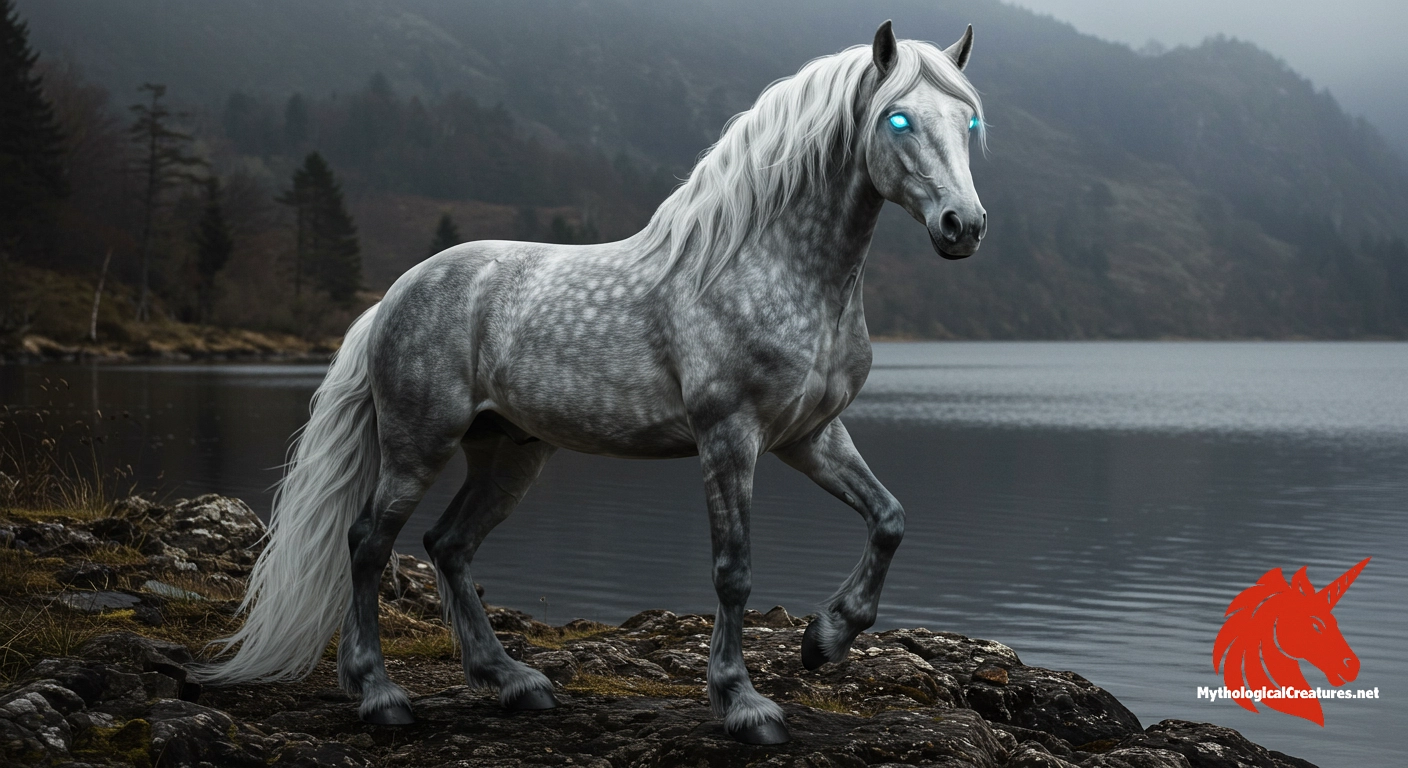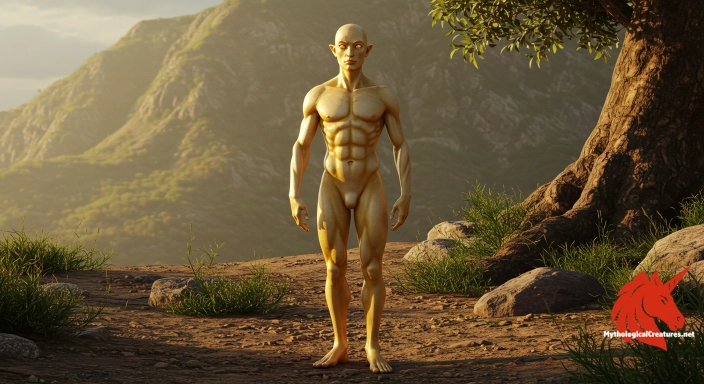Kelpie: The kelpie is a mythological water spirit from Scottish and Yorkshire folklore, typically appearing as a grey or white horse that can change into human form.

Kelpie
Kelpie - Served to warn people, especially children and young women, of the dangers of water and deceit
Origins & First Encounters
The kelpie emerges as a mysterious water spirit interwoven with the rich tapestry of Scottish and Yorkshire tradition, captivating imaginations with its dual existence. Its origins lie deep in the lochs and hidden waters of rural Scotland, where age-old oral transmissions first immortalised its spectral presence. The creature’s early depictions reveal a being capable of both allure and danger, as communities sought to make sense of the powerful forces of nature. With a form that oscillates between a magnificent equine figure and a subtly human guise, the kelpie continues to embody the paradoxical nature of beauty and threat. Its legend is steeped in moral overtones, serving as both a warning against the perils of secluded waters and a reflection of the human propensity for illusion. The spirit’s mythical essence is rooted in the interplay of natural and supernatural, evoking themes of seduction, betrayal, and the consequences of human curiosity. Over centuries, the kelpie has maintained a unique cultural resonance, blending ancient ritual with regional lore. Its enduring narrative mirrors the landscape from which it sprang, characterised by misty lochs and untamed wilderness. Deeply woven into the fabric of local identity, the legend of the kelpie continues to be celebrated as a symbol of both nature’s enchantment and its inherent dangers.
Source Texts & Tale Variants
Narratives concerning the kelpie have been primarily preserved through oral traditions that echo through the ages in the rural communities of Scotland and Yorkshire. Early folktales and local anecdotes vividly recount encounters with a spectral equine, each tale enriched by the nuances of regional storytelling. Poetic works, notably those of Robert Burns, have cemented its association with malevolent forces by subtly intertwining its image with elements of the supernatural. Diverse manuscript collections and compendiums of folklore have recorded variants where the kelpie appears with an otherworldly presence on fog-bound lochs. In many retellings, the creature glides silently near water’s edge, its form oscillating between enchanting beauty and ominous warning. Some narratives detail how the kelpie insists on retaining vestiges of its true nature, such as cloven hooves or mismatched features, even in human guise. A wealth of stories from the 18th and 19th centuries highlight its role as a cautionary figure meant to deter unwary travellers and curious onlookers near dangerous waters. Over time, these ancient accounts have accrued layers of meaning, making the kelpie a dynamic figure open to reinterpretation. Modern compilations continue to celebrate its multifaceted legend, ensuring that both classic and variant accounts remain influential in contemporary discourse.
Form & Powers
The kelpie is predominantly envisioned as a striking, otherworldly steed with a coat that varies from silvery grey to pristine white, reflecting the ethereal quality of its watery habitat. Its form is at once alluring and foreboding, with glistening eyes that seem to flicker like distant embers in the twilight. Descriptions frequently mention a sleek, muscular build that moves with a grace both natural and unnerving. Witness accounts sometimes speak of a spectral sheen that renders its appearance almost luminescent when shrouded in moonlight or mist. In many portrayals, even when the kelpie adopts a human form, it betrays its true identity by retaining subtle equine features such as hooves or a distinctive gait. This uncanny blend of human and horse is central to its mystique, challenging the boundary between man and nature. Variations in its depiction have led to interpretations that emphasise either a robust build or a more elongated, ghostly silhouette influenced by the reflective quality of water. Intricate details such as a flowing mane and a tail that seems to ripple like the surface of a loch further enhance its ethereal presence. The amalgamation of these physical attributes solidifies the kelpie’s status as a creature of both beauty and hidden peril.
Regional Faces
Across different regions, the kelpie’s depiction takes on a variety of intriguing nuances that echo local environmental and cultural influences. In the Scottish Highlands, it is often portrayed as an isolated, mysterious figure whose presence is as much a part of the wild terrain as the lochs themselves. Contrastingly, in parts of Yorkshire, the tales sometimes paint it as a more tangible and corporeal entity, blending seamlessly into the folklore of the surrounding countryside. Local adaptations frequently embed the kelpie within a broader framework of cautionary myth, particularly through narratives designed to keep children away from treacherous waters. In some regions, the spirit emerges not solely as a malevolent force but also as a tragic remnant of nature, embodying themes of loss and redemption. The creature’s mutable appearance, varying between a spectral horse and a beguiling human, is coloured by the local legends that speak of haunted lakes and mysterious drownings. Rural communities often reinforce the kelpie’s role as an omen, a harbinger that portends both the beauty and hazards of Scotland’s diverse water bodies. Even within Scotland, subtle differences in the telling of the tale reflect the distinct character of each area, adapting the myth to suit local fears and fascinations. Such regional variations enhance the multifaceted nature of the kelpie, ensuring that its legend remains as diverse and dynamic as the landscapes it haunts.
Cultural Parallels
The kelpie stands alongside a pantheon of water spirits that appear in various cultures, each sharing a common thread of enigmatic allure and inherent danger. In Germanic lore, the nixie assumes a role remarkably similar to the kelpie, often engaging in bewitching interactions with those who wander too close to its watery realm. Such entities, whether found in Celtic, Germanic, or other traditions, underscore a universal motif: water as a boundary between the known world and the mysterious unknown. Comparative analysis reveals that while these creatures may differ in detail—the haunting horse of Scotland versus the seductive mermaid-like figure in other cultures—they all serve as potent symbols of nature’s capricious power. The wihwin of Central America and the bunyip from Australia, for instance, each evoke both fear and fascination, blending local colour with global mythological themes. The similarities among these beings are manifest in their shared qualities of shapeshifting and an uncanny presence that defies conventional explanation. Their tales not only reflect deep-seated cultural anxieties about the natural world but also celebrate the allure of transformation and mystery. In drawing parallels between these diverse myths, one finds a vibrant dialogue that spans continents and centuries. This interconnectedness highlights how different cultures creatively interpret the perennial hum of nature’s hidden forces through the lens of legend.
Legacy & Modern Evolution
Over the centuries, the image of the kelpie has undergone a significant transformation, evolving from a terrifying embodiment of watery peril into a celebrated icon of cultural heritage. Early portrayals emphasised its ominous ability to lure unsuspecting victims into dangerous waters, embodying both moral warnings and the capricious nature of the wild. As literary and artistic traditions matured, so too did the interpretations of the kelpie, with modern retellings embracing its ethereal beauty and symbolic complexity. Contemporary depictions, including landmark public artworks such as the impressive 30-metre-high steel sculptures in Falkirk, have recast the kelpie as a proud emblem of Scotland’s rich folklore and innovative spirit. These modern incarnations blend ancient myth with the vibrancy of modern artistic expression, capturing both the heritage of the past and the dynamism of the present. The evolution in its representation speaks not only to shifting cultural attitudes but also to a broader reappraisal of traditional lore in a modern context. In academic and popular media alike, the kelpie is now regarded with a sense of nostalgic admiration, as well as a reminder of the enduring power of myth. Contemporary festivals, exhibitions, and creative projects continue to explore its narrative, ensuring that the mysterious allure of the kelpie inspires future generations. Its lasting legacy, therefore, lies in its ability to bridge the gap between historical myth and modern creativity, sustaining a dialogue that enriches Scotland’s cultural landscape.
Interesting Fact
The kelpie's depiction in monumental sculptures, notably The Kelpies in Falkirk, underscores its lasting influence on both ancient folklore and modern art.
Quick Creature Info
Features:
Associations:
Our Mythic Legendary Rating:

Also Sometimes Known As:
Habitat:
Supernatural Powers:
Physical Attributes:
Abilities:
Behavior:
Weaknesses:
Lore:
References
Discover Another Mythical Legend You May Not Have Heard Of?
Uncover the mysteries of ancient folklore and expand your knowledge of legendary beings from cultures around the world.
Dare to Meet the Ashi....
Mythical Disclaimer: The images and data on this site are derived from various historical and literary sources, but we have found that many myths often have multiple versions and interpretations across references, sometimes contradictory. As a result, these creature depictions are artistic interpretations—imaginative blends of folklore, legend, and a dash of AI guesswork. Because creature descriptions vary widely, our illustrations and accompanying information represent our best effort to honor mythology while bridging creative gaps. Enjoy these interpretations—just remember, we've done our best to respect the stories and validate available data, but in the realm of mythology, details often shift, imagination leads the way, and nothing is ever set in stone!
Curated by the Mythological Creatures Team (rev. May 2025)
